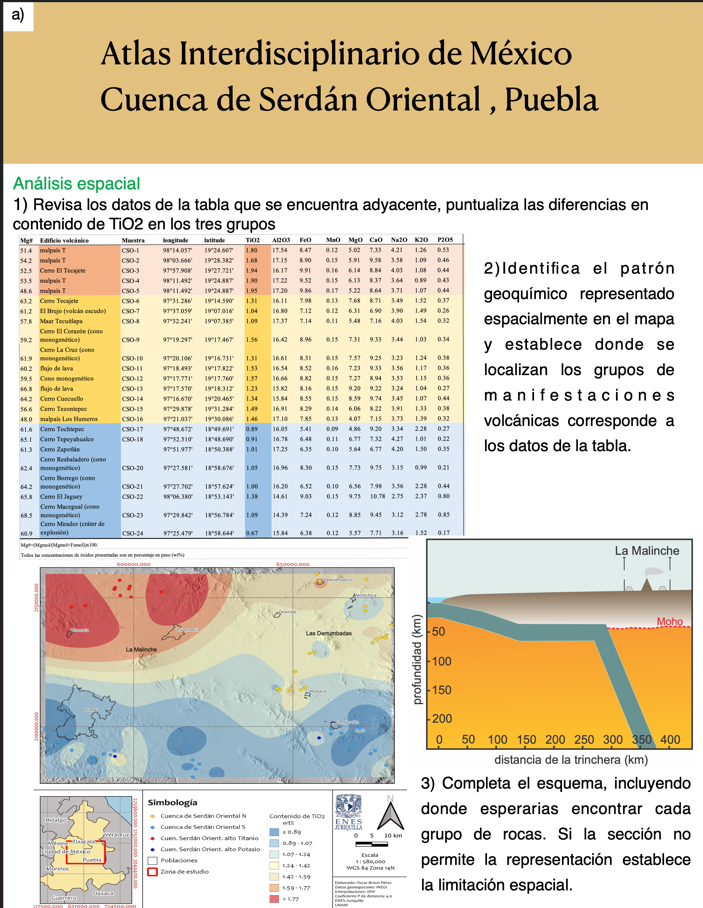Abstract
In recent years, the Earth, society and the environment have been
facing severe climate, energy, food and water crises. In academic
education, this situation motivate teachers to train professionals
capable of understanding the importance of interdisciplinarity
and transdisciplinarity and the application of the knowledge they
acquire in solving multivariate problems in complex systems. Earth
science education needs to implement innovative and stimulating
teaching techniques to develop Earth Systemic Thinking (EST).
Teachers dealing with Earth System topics must be aware that
the student body is made up of people with heterogeneous and
academically diverse profiles and, consequently, using traditional,
discursive and unidirectional teaching-learning techniques reduces
the possibilities of acquiring higher-order skills such as analysis,
synthesis and problem solving. In this paper we present a chapter
model for the ‘Interdisciplinary Atlas of Mexico’ using data from a
study on the Serdán-Oriental Basin with conducted activities that
allow the exercise of trans-disciplinary systems thinking with a
view to training skilled professionals to contribute to the solution
of global problems facing society. We also present the results of
the educational intervention during 2022 that demonstrate that the
application of this teaching model stimulates autonomous learning
and the resolution of complex problems, with a view to fulfilling the
objective of quality education and the reduction of inequalities.
References
Anderson, L. W., y Krathwohl, D. R. (2001). A taxonomy for learning, teaching, and assessing: A revision of Bloom’s taxonomy of educational objectives: complete edition. Addison Wesley Longman, Inc.
Becerra-Torres, E., Mori, L., Gómez-Tuena, A., Bravo-Pérez,B., The magmatic diversity of the Serdán-Oriental Basin as a key to understand the geochemical recycling and sub-arc mantle processes. In process.
Brilha, J. (2016). Inventory and Quantitative Assessment of Geosites and Geodiversity Sites: a Review. Geoheritage, 8(2), 119–134. https://doi.org/10.1007/s12371-014-0139-3
Canet, C. (2023). Is Mexico a “Megageodiverse” Country? In Geoheritage (Vol. 15, Issue 3). Springer. https://doi.org/10.1007/s12371-23-00865-2
Change, G. (2004). the Earth System: A planet under pressure. Executive Summary, Utgiven Av International Geosphere-Biosphere Programme (IGBP).
Donner, R., Barbosa, S., Kurths, J., y Marwan, N. (2009). Understanding the Earth as a Complex System–recent advances in data analysis and modelling in Earth sciences. The European Physical Journal Special Topics, 174, 1–9.
Esther, N., Matos, P., Setién, E., y Ii, Q. (2008). La interdisciplinariedad y la transdisciplinariedad en las ciencias: una mirada a la teoría bibliológico-informativa. Acimed, 18(4).
García-Sánchez, L., Canet, C., Cruz-Pérez, M., Morelos-Rodríguez, L., Salgado-Martínez, E., y Corona-Chávez, P. (2021). A comparison between local sustainable development strategies based on the geoheritage of two post-mining areas of Central Mexico. International Journal of Geoheritage and Parks, 9(4), 391–404. https://doi.org/10.1016/j.ijgeop.2021.10.001
Herbert, B. E. (2006). Student understanding of complex earth systems. Special Paper of the Geological Society of America, 413(413), 95–104. https://doi.org/10.1130/2006.2413(07)
Indorf, J. L., Benabentos, R., Daubenmire, P., Murasko, D., Hazari, Z., Potvin, G., Kramer, L., Marsteller, P., Thompson, K. V., Cassone, V. M., y Stanford, J. S. (2021). Distinct factors predict use of active learning techniques by pre-tenure and tenured STEM faculty. Journal of Geoscience Education, 69(4), 357–372. https://doi.org/10.1080/10899995.2021.1927461
Jacobson, M., Charlson, R. J., Rodhe, H., y Orians, G. H. (2000). Earth System Science: from biogeochemical cycles to global changes. Academic Press.
Kastens, K. A., y Manduca, C. A. (2012). Earth and mind II: A synthesis of research on thinking and learning in the geosciences (Vol. 486). Geological Society of America.
Kozlowski, S. (2004). Geodiversity. The concept and scope of geodiversity. Przeglad Geologiczny, 52(8).
Manduca, C. A., y Mogk, D. W. (2006). Earth and mind: How geologists think and learn about the earth (Vol. 413). Geological Society of America.
Meléndez Hevia, I. (2009). Introducción y conceptos previos. (Vol. 17, Issue 1).
Orion, N. (2024). Geoscience education: Changing paradigms. In Geoethics for the Future (pp. 333–338). Elsevier.
Palacio Prieto, J. L., Martínez, G. F. de C., y González, E. M. R. (2019). Geotrails in the mixteca alta UNESCO Global Geopark, Oaxaca, Mexico. Cuadernos Geograficos, 58(2), 111–125. https://doi.org/10.30827/cuadgeo.v58i2.7055
Paoli-Bolio, F. J. (2019). multi-inter y transdisciplinariedad. Anuario de Filosofía y Teoría Del Derecho, 13, 347–357.
Piaget, J., Garcia, R., y García, R. (2006). Filosofía de la Ciencia Hacia una lógica de significaciones. www.gedisa.com
Ram, M. P., Ajay, K. K., y Gopinathan Nair, A. (2020). Geoscience Curriculum: Approach Through Learning Taxonomy and Outcome Based Education. Higher Education for the Future, 7(1), 22–44. https://doi.org/10.1177/2347631119886403
Rockström, J., Steffen, W., Noone, K., Persson, Å., Chapin III, F. S., Lambin, E., Lenton, T. M., Scheffer, M., Folke, C., y Schellnhuber, H. J. (2009). Planetary boundaries: exploring the safe operating space for humanity. Ecology and Society, 14(2).
Soltis, N. A., McNeal, K. S., Forbes, C. T., y Lally, D. (2019). The relationship between active learning, course innovation, and teaching Earth systems thinking: A structural equation modeling approach. Geosphere, 15(5), 1703–1721. https://doi.org/10.1130/GES02071.1

This work is licensed under a Creative Commons Attribution-NonCommercial 4.0 International License.
Copyright (c) 2024 Universidad Nacional Autónoma de México

